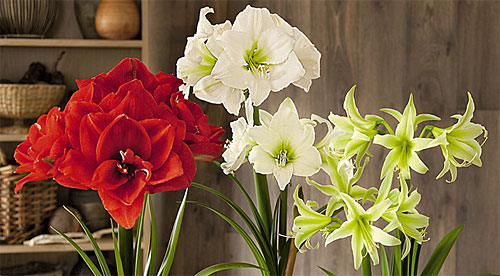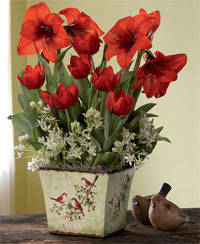





As a founding employee of Gardener's Supply, I wore many different hats over the years. Currently, I have my own company called Johnnie Brook Creative. The gardens around my home in Richmond, VT, include a large vegetable garden, seasonal greenhouse, cutting garden, perennial gardens, rock garden, shade garden, berry plantings, lots of container plants and a meadow garden. There's no place I'd rather be than in the garden.

Amaryllis blooms brighten the home in winter. What's more, they are among the easiest bulbs to grow indoors.
The following bulbs are the easiest to force into bloom because they don't require a chilling period:
Tulips
The following varieties are recommended for forcing:
Crocus
Most of the large-flowered varieties force well.
Hyacinths
All varieties force well.
Daffodils
Select double-nosed bulbs for more blooms.
Source: Bulbs: Four Seasons of Beautiful Blooms by Lewis and Nancy Hill, Storey Communications, 1994.
The list below recommends the number of weeks of chilling required, followed by the number of weeks until bloom (in parentheses).
Source: The Netherlands Flower Bulb Information Center
GROWING bulbs indoors lets you enjoy the colors and fragrance of spring when it's still months away. The key to success with indoor bulbs is to plan ahead.
Many people don't realize that there are two types of bulbs for indoor growing: those you need to chill and those you don't. Here's how to tell the difference.
These bulbs are native to warm climates, so they don't require a cooling period to trigger blooms. Amaryllis and paperwhite narcissus both belong in this category.

Another option for indoor bulbs: Buy a planted basket. The bulbs have already been chilled and are ready to bloom.
You can grow these bulbs in a pot filled with soil, or just place them in a shallow bowl and use pebbles to hold the bulbs in place. Add water, and they'll usually bloom just four weeks after "planting". To help keep stems short and sturdy, start them out with indirect light and temperatures of about 50 degrees F. for the first two weeks, then warmer, brighter conditions after that. If you're growing your bulbs in a bowl with pebbles or marbles, the water should cover no more than the bottom quarter to third of the bulb.
Amaryllis are available in many interesting colors and forms: There are bright reds, as well as white, pink and peach. For more information, read Amaryllis Care.
Paperwhites offer delicate beauty and an intense fragrance. Buy a couple dozen paperwhite bulbs and store them in a cool, dry place. Start some every few weeks for blooms right through February.
All other spring bulbs require a chilling period before they'll bloom. This includes tulips, daffodils, hyacinths, crocus, Dutch iris and scilla. Cool temperatures stimulate a biochemical response inside the bulb that "turns on" the embryonic flower so it starts developing. Most bulbs require 16 to 18 weeks of cold before the flower is fully formed. At that point they're ready for light and warmth. If you cut the cooling time short, the flowers may emerge but they will probably be stunted and deformed.
For indoor blooms, the easiest bulbs are crocus, hyacinths, muscari, and mini-daffodils. Tulips and standard daffodils can also be forced, but they require more careful attention.
Bulbs look best in a shallow, wide pot that's 4" to 6" deep. There should be at least 2" below the bulbs for root growth. The very top of the bulbs can be even with the pot rim. Use a standard potting mix (2/3 soilless mix, 1/3 compost/soil). Potted bulbs also look best when they're crowded, so snuggle the bulbs together about 1/2-inch apart. It's also good to stick with one variety of bulb per pot, because cooling and bloom times vary. Water thoroughly after planting, and label each of your pots with variety name and planting date. Otherwise, you won't remember what's what when they are coming into bloom.
Finding the right place to chill your bulbs is usually the biggest challenge. Once planted, the bulbs need to be kept at 35 to 45 degrees F. for the entire cooling period of 16 to 18 weeks. If you live where outdoor winter temperatures rarely get below 25 degrees F, just keep the pots of bulbs moist and store them right in the garden beneath a layer of straw. If your winter temperatures are colder than that, the potted bulbs can be stored in an unheated basement, a ventilated crawlspace, or a cold frame.
Check the information at right for specifics about how long to chill your bulbs. Generally, if you want to have flowers blooming in January, you should plant your bulbs in September or early October. For February flowers, plant mid-October. For March blooms, plant in late October or early November. Keep the soil moist, but not wet for the entire chilling period. And keep the bulbs in the dark or they may start growing before they're fully chilled.
Once you remove your bulbs from cold storage, allow three or four weeks to bloom time. Wake the bulbs gradually, starting with about two weeks of indirect sunlight and 60 degree temperatures. When shoots are three to five inches high, move the pots to a 68-degree environment and a bright, sunny window. Once buds color, move the pot to indirect light again to prolong bloom.
After blooming, most people discard potted bulbs. If you find that impossible, keep watering the pots and start adding some fertilizer. When the foliage yellows (usually after a month or two), you can remove the bulbs and plant them outdoors. Just remember, it may be several years before the bulbs build up enough reserves to bloom again. Paperwhites and other tropical narcissus will not rebloom.
Copyright © www.100flowers.win Botanic Garden All Rights Reserved